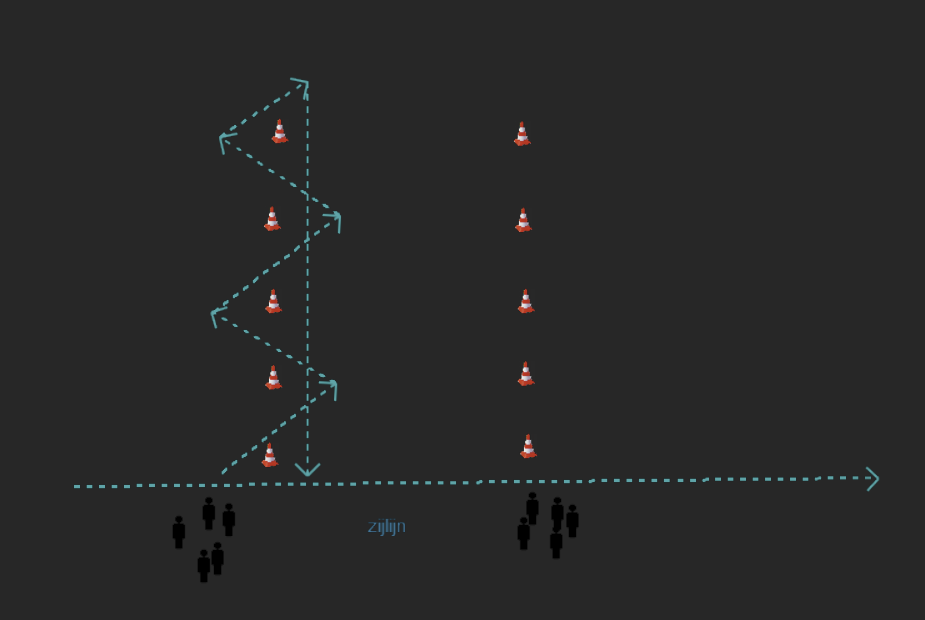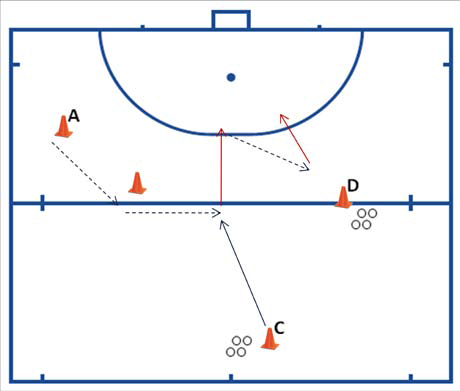Hockey drills for technique 1,5 meter / corona / covid-19

- A slalom exercise
- watch how the hands are holding the stick
- where they have the ball
- And if they use the stick properly when they run through the exercise!
- If it goes well, you can make a game of it and see if they master this. The team that has been through all the exercises first has won.
- Players divided into two groups on one side of the field.
- Two rows of cones next to each other.
- Players pass the ball back and forth while walking past the cones.
- Variations
- Individuals keep ball high along a row of cones, both groups independent of each other.
- Passing the ball two by two
- Individually dribble two balls at the same time, slalom through the cones
- Pass the ball and dribble a second ball at the same time (player says yes).
- Three of you play over 2 balls to the other side.
Purpose
- Practicing different techniques. (Also useful to observe how things are going during the 1st training).
Set up
- All players line up on the baseline (or another line) and do a certain
- and do a certain exercise until the 23m line (or another line).
- This can be only floating, or floating + at whistle a drag or lift, etc.
- Important is that it is not about the fastest, but the best!
- You can make it easier or more difficult by making a difference in the exercise.
Goal
- To regain that ball feeling and get back into the swing of things.
Set up
- The players form pairs
- and they stand opposite each other on a few meters (5 for example).
- Then they start pushing each other.
- At a certain moment, they take some more distance and start flattening.
Goal
- The goal of this exercise is to learn to look ahead when floating. In addition, you train your ability to react.
Set up
- The players line up on, for example, the back line.
- The trainer stands 10-15 metres away from the players.
- At an agreed signal, the players start drifting towards an imaginary line at your height.
- But in the meantime, they have to look in front of them, because you raise a certain number of fingers and the players have to say that number.
- To make this exercise more difficult, you can ask the players to make a passing move on an agreed signal, or you can make the distance bigger, or the players have to walk instead of saying the number, to a point which corresponds with the number.
- A plays the ball to the incoming B
- B rebounds the ball
- A drives a little
- B offers himself wide and A plays the ball into the space to B
- Because of B's running action outside, C makes space by running inside.
- B accelerates during his running action with the ball over the back line.
- C has gone towards the dot
- B passes, C rounds off (one-touch).
Variation: Exercise 2x.
Start with a three-run.
- A floats with the ball, when A is halfway, he pushes the ball out of the run to B.
- B does the same (to C)
- etc.
- Apply differentiation.
Possibly after this warm-up play another game of possession.
- Position the pawns as shown in the figure
- Spread the balls on pylons C and D.
- In this exercise you place a player on the pylons C and D.
- The rest of the team lines up at the A-post.
- From A the player walks around the pylon
- From the pylon, the player makes a sideways movement, facing the ball (facing C)
- Player C plays the ball into the forehand of A
- A takes the ball and turns to the right to open
- A runs towards the circle and finishes on goal.
- From here he runs to D and receives another ball.
- The player turns open to the left and again finishes on goal.


Goal: Improve passing. To improve finishing on goal.
Organisation: Half playing field 2 attackers (Z) â€" 1 goalkeeper Course with 1,2-ties, dribbling and finishing on goal. After each pass you have to run to get the ball back from the attacker.
Tip: Before shooting on goal, pay attention to the position of the goalkeeper!
Variations: Practise different passing moves, both anti-clockwise and clockwise.
The exercises can be played in 2 variants the variant for really beginning hockey players (this exercise can be used for a clinic for example) and the variant intended for beginning hockey players who have already been in touch with hockey.
Variation 1:
- Player 1 plays the ball to player 2,
- Player 2 receives the ball and passes to player 3.
- Player 3 receives the ball and shoots at goal.
- Player 4 tries to stop the ball with the bottom of his foot or with his stick.
- Player 4 retrieves the ball and joins the back of the line at the starting pawn of player 1.
- For safety's sake don't shoot on target when player 4 picks up the ball.
- It is also possible to get the balls out of the goal later or use a break for that.
- This is for safety reasons.
- Player 1 plays ball on player 2.
- player a runs on and receives the ball back, player 1 now plays ball on player 3 and receives the ball back again and shoots the ball at goal.
- variation:
- instead of shot on goal,
- gives player 1 a pass for the goal on player 4
- player 1 takes the place of player 4.
- player 2 and 3 remain.
- This is a basic exercise in preparation.
- Just like a tennis player who prepares for training with basic strokes, the players must prepare for the complex training and competition forms, with direct simple passes on top of each other.
- In this way, the trainer has the ability to see technical errors in each individual player and correct them as early as the basic exercise.
- The players pass the ball directly between two pylons and walk counter-clockwise to the other side.
- The size of the target and the distance between the players will be adjusted according to the age and level of the players.








